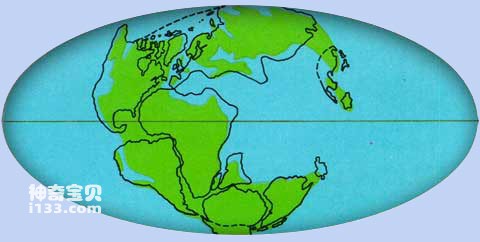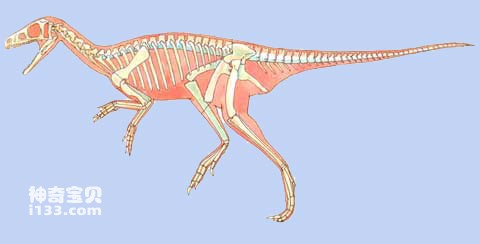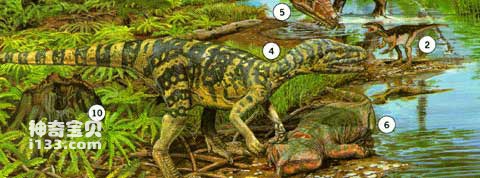In the late Triassic period about 230 million years ago, the first dinosaurs evolved from some reptiles. They were one of many new animal groups on land at that time. At the same time, other new forms of life conquered the skies and seas of that era.

Earth in the late Triassic, showing Pangea
At that time, the slowly drifting landmasses on the earth merged along the equator to form a supercontinent. This supercontinent was called Pangea by geologists. The climate in Pangea was warm throughout and gradually becoming drier. Conifers, cycads, and ferns abound where moisture is available. The grasses, flowering plants, and broadleaf trees we are familiar with today had not yet evolved at that time.
The first dinosaurs were born in such an environment.
There is a place called Moon Valley in northwest Argentina, where scientists have discovered many precious fossil skeletons of early dinosaurs and other large reptiles. Today's Moon Valley is a barren desert, but in the late Triassic period 230 million years ago, it was a warm, humid riverside with lush vegetation.
As early as 50 years ago, scientists discovered a carnivorous dinosaur called Herosaurus here. But it was only in the past 10 years, with the discovery of more fossil materials and the deepening of research work done by scientists in the laboratory, that Herosaurus and many other animals found in this area began to be recognized by us. .
Over the years, the skeleton fossils of Heurusaurus have been discovered repeatedly, but unfortunately, no skull fossils have been found. You know, for studying the occurrence and origin of a certain animal, no skeletal fossil can provide us with more clues than skull fossils.
It wasn't until one day in 1988 that Dr. Sereno, an American paleontologist who came to the Moon Valley to investigate, discovered the first skull fossil of Helicosaurus while wandering in the desert. The skull is so well preserved that even the bone rings inside the eye sockets are still intact.
The research in the laboratory is really surprising. The ossicles in the ears of Herysaurus show that this dinosaur may have keen hearing; the long claws and upper and lower jaws with sharp teeth show that it was a hunter and killer that frightened other animals; the upright posture shows that , for that era, Black Ruilong was nimble, agile and fast. The body of Black Ruilong can grow to 3 to 6 meters long and weigh 360 to 450 kilograms. It is much larger than the largest carnivorous beasts on modern land, lions and tigers.

Eoraptor skeleton

Hei Ruilong
In 1993, Dr. Sereno and his colleagues discovered another well-preserved and almost complete skeleton fossil of a new species of dinosaur during their second Moon Valley expedition. They named it Eoraptor. Compared with Black Ruilong, Eoraptor is like a cat compared with a tiger, because it is only a few centimeters long, less than 1 meter, and weighs only 5 to 7 kilograms. Interestingly, on the upper and lower jaws of Eoraptor, the teeth at the back are like slotted steak knives, similar to other carnivorous dinosaurs; but the teeth at the front are leaf-shaped, similar to other vegetarian dinosaurs. This feature suggests that Eoraptor likely ate both plants and meat.
Some characteristics of Eoraptor prove that it is one of the earliest dinosaurs on earth. For example, it has 5 "fingers", while the number of "fingers" of carnivorous dinosaurs that appeared later tended to decrease. At the end, large carnivorous dinosaurs such as Tyrannosaurus rex had only two "fingers" left. For another example, Eoraptor had only three vertebrae in its waist to support its small belt. However, as later dinosaurs became larger and larger, the number of vertebrae in the waist that supported the belt increased.
However, Eoraptor also has some characteristics that are the same as those of Black Ruisaurus and various carnivorous dinosaurs that appeared later. For example, it didn't have the extra attachment in the middle of its lower jaw that some vegetarian dinosaurs have. Another example is that its pubic bone is not particularly large.
The emergence of Eoraptor and Herosaurus in the late Triassic represents the dawn of the age of dinosaurs.
animal tags:
We created this article in conjunction with AI technology, then made sure it was fact-checked and edited by a Animals Top editor.